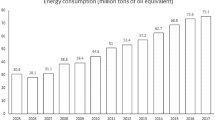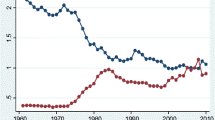Abstract
The US manufacturing sector, which consists of industries that produce durable and nondurable goods, accounts for about 30 % of all the final energy consumed in the country. In this study, manufacturing sector data coming primarily from the Annual Survey of Manufacturers are used to estimate the total impact of one mode of energy efficiency policy, market persuasion programs, on aggregate electricity consumption and energy expenditures. Using a panel model consisting of data for 184 industries, the findings indicate that the cumulative effects since 2002 of this policy mode is a reduction in 2010 electricity consumption of 5.4 %, of electricity expenditures of 2.4 %, and of all other fuel expenditures of 5.7 %. These estimates are derived after controlling for changes in output, other production inputs, and economic conditions. Particular attention in this study is given to the effects of a permanent shift in demand, and temporary business cycle shock, on model external validity.




Similar content being viewed by others
References
Arimura, T. H., Shanjun, L., Richard, G. N., & Karen, P. (2012). “Cost-effectiveness of electricity energy efficiency programs. The Energy Journal, 33(2), 63–100.
ASM (Annual Survey of Manufacturers) (2011). www.census.gov/manufacturing/asm. US Census Bureau, Washington.
Auffhammer, M., Carl, B., & Meredith, F. (2008). Demand side management and energy efficiency revisited. The Energy Journal, 91(3).
Bernstein, M. K., Kateryna, F., Sam, L., & David, L. (2003). State-level changes in energy intensity and their national implications. MR-1616-DOE. Santa Monica: Rand.
Bohi, D. R. (1981). Analyzing demand behavior. Baltimore: Johns Hopkins University Press for Resources for the Future.
Bohi, D. R., & Zimmerman, M. B. (1984). An update on econometric studies of energy demand behavior. Annual Review of Energy, 9, 105–154.
Boyd, G., Kuzmenko, T., Szemely, B., & Zhang, G. (2011). Preliminary analysis of the distributions of carbon and energy intensity for 27 energy intensive trade exposed industrial sectors, working paper EE 11–03, Nicholas institute for environmental policy solutions. Chapel Hill: Duke University.
CEE. (2011). State of the efficiency program industry: Expenditures, impacts, & budgets 2011. Boston: Consortium for Energy Efficiency.
Dahl, C. (1993). A survey of energy demand elasticities in support of the development of the NEMS. Washington: US Department of Energy.
DEER (2011). www.deeresources.com. California Energy Commission, California Public Utilities Commission, San Francisco–Sacramento.
EIA (Energy Information Administration). (2011). Annual energy outlook. Washington: US Department of Energy.
Horowitz, M. J. (2007). Changes in electricity demand in the United States from the 1970s to 2003. The Energy Journal, 28(3), 93–119.
Loughran, D. S., & Kulick, J. (2004). Demand side management and energy efficiency in the United States. The Energy Journal, 25(1), 19–43.
Parfomak, P. W., & Lave, L. B. (1996). How many kilowatts are in a negawatt? verifying ex post estimates of utility conservation impacts at the regional level. The Energy Journal, 17(4), 59–87.
Rivers, N., & Jaccard, M. (2011). Electric utility demand side management in Canada. The Energy Journal, 32(4), 93–116.
SEDS (2011). www.eia.gov. Energy Information Administration, Washington.
Acknowledgments
This research was funded by the US Environmental Protection Agency. The author would like to thank Elizabeth Dutrow and Caterina Hatcher as well as the anonymous referees for their comments and suggestions. The author takes sole responsibility for all errors and opinions found within.
Author information
Authors and Affiliations
Corresponding author
Rights and permissions
About this article
Cite this article
Horowitz, M.J. Purchased energy and policy impacts in the US manufacturing sector. Energy Efficiency 7, 65–77 (2014). https://doi.org/10.1007/s12053-013-9200-3
Received:
Accepted:
Published:
Issue Date:
DOI: https://doi.org/10.1007/s12053-013-9200-3




